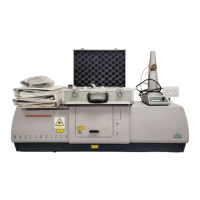It is usual at this point to go on and analyse the measurement but it can be
saved on the computer so that it can be analysed at a later date if you wish.
How to analyse the measurement data
There are three steps required to analyse the measurement data:
.
Choose the analysis model to be used.
.
Choose the presentation to be used.
.
Tell the computer to calculate the result.
The analysis model
The analysis model tells the computer what the expected shape of the result graph
will be. There are four choices available; polydisperse, multimodal, monomodal
or very polydisperse.
Polydisperse model does not assume anything about the shape of the
result graph.
Multimodal model assumes that there will be one or more distinct peaks
in the results graph - indicating that there are several distinct sizes of
particles.
The monomodal model assumes that there will only be one peak in the
result graph - indicating that there is only one size of particle.
Very polydisperse is similar to polydisperse but is only used for one or
two special circumstances. (For Mastersizer X only.) See chapter 5 for more
information.
Compressed range analysis has a reduced upper size limit and is meant
for use with dry powder and spray measurements. (For Mastersizer S only.)
The choice of which model to use is very simple - unless you definitely know
that the result graph will be of a particular shape always use the polydisperse
model.
The presentation
As stated earlier, the Mie theory needs to know specific information about the
structure of the sample and the medium it is suspended in so that it can calculate
exactly how light passes through them. The specific information required is the
relative refractive index of the particle to be measured, the particle adsorption
CHAPTER 3
Getting Started
Page 3.6
MAN 0101

